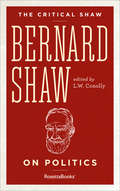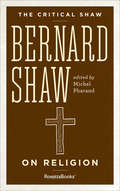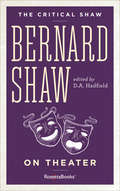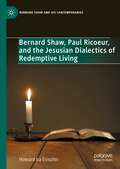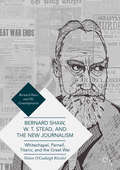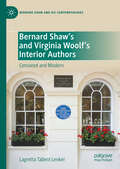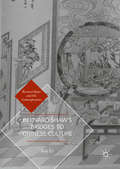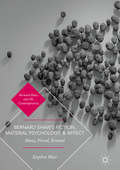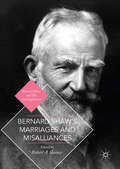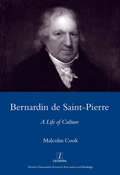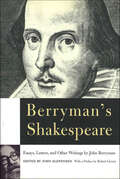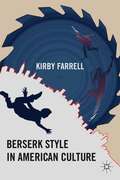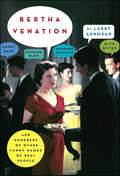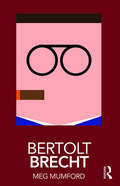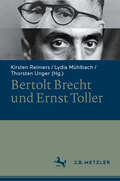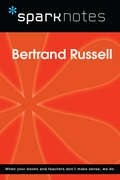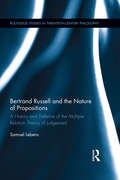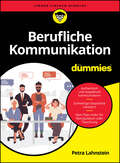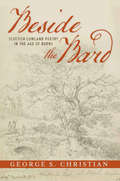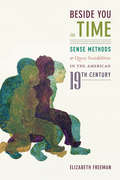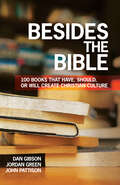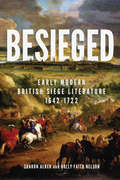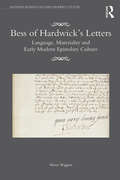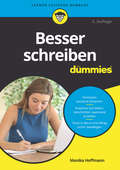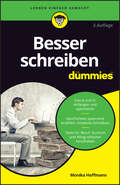- Table View
- List View
Bernard Shaw on Politics: On Politics (The Critical Shaw)
by George Bernard ShawA collection of critical writings on politics from the Nobel Prize – winning playwright behind Saint Joan and Man and Superman. The Critical Shaw: On Politics is a comprehensive selection of renowned Irish playwright and Nobel Laureate Bernard Shaw&’s opinions on a wide range of political movements, ideologies, and events that helped shape the international landscape of the late nineteenth and early twentieth centuries. With unwavering conviction, and in many cases openly courting controversy and calumny, Shaw spoke his mind on the big &“-isms&” of his time: Socialism, Capitalism, Communism, and Fascism. He championed Socialism in its formative years, he condemned all combatants in the First World War, he berated America&’s embrace of Capitalism, he praised Russia&’s choice of Communism, he lauded Stalin, he rejected the notion that Hitler was responsible for the Second World War, and he scorned Democracy. Persistently provocative, sometimes outrageous, always the political iconoclast, Shaw's political convictions—as soapbox orator or world-famous pundit—challenge us to face the political issues and dilemmas of our own time with similar rigor and integrity.The Critical Shaw series brings together, in five volumes and from a wide range of sources, selections from Bernard Shaw&’s voluminous writings on topics that exercised him for the whole of his professional career: Literature, Music, Politics, Religion, and Theater. The volumes are edited by leading Shaw scholars, and all include an introduction, a chronology of Shaw&’s life and works, annotated texts, and a bibliography. The series editor is L.W. Conolly, literary adviser to the Shaw Estate and former president of the International Shaw Society.
Bernard Shaw on Religion: On Religion (The Critical Shaw)
by George Bernard ShawFrom the Nobel Prize–winning playwright behind Pygmalion and Saint Joan, a collection of his critical writings on religion.The Critical Shaw: On Religion is a comprehensive selection of renowned Irish playwright and Nobel Laureate Bernard Shaw&’s pronouncements—many of them deliberately inflammatory—on all facets of religion and belief: on Christianity and the Church; on various religions, among them Protestantism, Catholicism, Quakerism, Christian Science, Fundamentalism, Calvinism, Hinduism, Judaism, and Islam; on atheism and agnosticism, atonement and salvation; the crucifixion, the resurrection, transubstantiation, and the Immaculate Conception; on the Bible, the Ten Commandments, the Book of Common Prayer, and the Thirty-nine Articles of the Anglican Church. And much more. In speeches, essays, and prefaces, Shaw relentlessly scrutinized and critiqued scores of religions—only to find most of their doctrines in need of exhaustive reform. And yet, in keeping with his many other paradoxes, though Shaw was fond of calling himself an atheist, he nonetheless recognized the importance, indeed the necessity, of religion.The Critical Shaw series brings together, in five volumes and from a wide range of sources, selections from Bernard Shaw&’s voluminous writings on topics that exercised him for the whole of his professional career: Literature, Music, Politics, Religion, and Theater. The volumes are edited by leading Shaw scholars, and all include an introduction, a chronology of Shaw&’s life and works, annotated texts, and a bibliography. The series editor is L.W. Conolly, literary adviser to the Shaw Estate and former president of the International Shaw Society.
Bernard Shaw on Theater: On Theater (The Critical Shaw)
by George Bernard ShawA collection of critical writings on theater from the Nobel Prize–winning playwright behind Man and Superman and Pygmalion.The Critical Shaw: On Theater is a comprehensive selection of essays and addresses about drama and theater by renowned Irish playwright and Nobel Laureate Bernard Shaw. An outspoken critic of the melodramas and formulaic farces that comprised most of the popular theater in the late nineteenth century, Shaw relentlessly campaigned for audiences, actors, theater managers, and even government officials to take theater more seriously, to use the stage as a forum for representing complex real issues such as poverty, marriage and divorce laws, sexual attraction, gender equality, and political power, so that through seeing them acted out, audiences could better understand and address them when they left the theater. Shaw&’s commitment to social reform through theater was matched by his expertise in the artistic and practical aspects of drama: whether he was reviewing productions, lecturing about acting, or schooling agents on royalties and copyright law, Shaw set a standard for intelligent professionalism that our own theaters might still aspire to and be measured against.The Critical Shaw series brings together, in five volumes and from a wide range of sources, selections from Bernard Shaw&’s voluminous writings on topics that exercised him for the whole of his professional career: Literature, Music, Politics, Religion, and Theater. The volumes are edited by leading Shaw scholars, and all include an introduction, a chronology of Shaw&’s life and works, annotated texts, and a bibliography. The series editor is L.W. Conolly, literary adviser to the Shaw Estate and former president of the International Shaw Society.
Bernard Shaw, Paul Ricoeur, and the Jesusian Dialectics of Redemptive Living (Bernard Shaw and His Contemporaries)
by Howard Ira EinsohnThis book explores a heretofore unremarked linkage between Bernard Shaw, the twentieth-century French thinker Paul Ricoeur, and Jesus of Nazareth. The ties that bind them are a foundational interest in the social teachings of the Nazarene and their use of a shared dialectics with respect to living the kind of compassionate life that holds out the promise in our contemporary world of achieving something approximating universal wellness on a healthy planet at peace with itself. This work argues that the three principal subjects of the study—independently of one another—used the same dialectical method to reach the same dialectically derived conclusion about how humans can live redemptively in a fractured world.
Bernard Shaw, W. T. Stead, and the New Journalism
by Nelson O'Ceallaigh RitschelThis book explores Bernard Shaw’s journalism from the mid-1880s through the Great War—a period in which Shaw contributed some of the most powerful and socially relevant journalism the western world has experienced. In approaching Shaw’s journalism, the promoter and abuser of the New Journalism, W. T. Stead, is contrasted to Shaw, as Shaw countered the sensational news copy Stead and his disciples generated. To understand Shaw’s brand of New Journalism, his responses to the popular press’ portrayals of high profile historical crises are examined, while other examples prompting Shaw’s journalism over the period are cited for depth: the 1888 Whitechapel murders, the 1890-91 O’Shea divorce scandal that fell Charles Stewart Parnell, peace crusades within militarism, the catastrophic Titanic sinking, and the Great War. Through Shaw’s journalism that undermined the popular press’ shock efforts that prevented rational thought, Shaw endeavored to promote clear thinking through the immediacy of his critical journalism. Arguably, Shaw saved the free press.
Bernard Shaw’s and Virginia Woolf’s Interior Authors: Censored and Modern (Bernard Shaw and His Contemporaries)
by Lagretta Tallent LenkerVirginia Woolf and Bernard Shaw may be the odd couple of Twentieth Century modernism. Despite their difference in age (Shaw was twenty-six years older than Woolf), and public demeanor - Shaw sought public attention while Woolf shunned the spotlight - they actively held similar convictions on most of the pressing and controversial issues of the day. This book demonstrates that both engaged in social reform through the Fabian Society; both took public anti-war positions and paid dearly for it; both fought British censorship throughout most of their careers as writers; both sought to strengthen women’s rights; and both endeavored to revolutionize their respective art forms, believing that art could bring about positive social change. The main focus of the book, however, concerns how both also created interior authors - characters who write and who either self-censor their own works or highly publicized messages or are censored by their fellow characters. These fictional authors maybe considered reflections of their creators and their respective milieus and serve to illuminate the satisfactions and torments of each famous author during the writing process.
Bernard Shaw’s Bridges to Chinese Culture (Bernard Shaw and His Contemporaries)
by Kay LiThis book explores the cultural bridges connecting George Bernard Shaw and his contemporaries, such as Charles Dickens and Arthur Miller, to China. Analyzing readings, adaptations, and connections of Shaw in China through the lens of Chinese culture, Li details the negotiations between the focused and culturally specific standpoints of eastern and western culture while also investigating the simultaneously diffused, multi-focal, and comprehensive perspectives that create strategic moments that favor cross-cultural readings. With sources ranging from Shaw's connections with his contemporaries in China to contemporary Chinese films and interpretations of Shaw in the digital space, Li relates the global impact of not only what Chinese lenses can reveal about Shaw's world, but how intercultural and interdisciplinary readings can shed new light on familiar and obscure works alike.
Bernard Shaw’s Fiction, Material Psychology, and Affect: Shaw, Freud, Simmel (Bernard Shaw And His Contemporaries Ser.)
by Stephen WattThis book traces the effects of materiality - including money and its opposite, poverty - on the psychical lives of George Bernard Shaw and his characters. While this study focuses on the protagonists of the five novels Shaw wrote in the late 1870s and early 1880s, it also explores how materialism, feeling, and emotion are linked throughout his entire canon. At the same time, it demonstrates how Shaw’s conceptions of human subjectivity parallel those of two of his contemporaries, Sigmund Freud and Georg Simmel. In particular, this book explores how theories of so-called 'marginal economics' influence fin de siècle thought about human psychology and the sociology of the modern metropolis, particularly London.
Bernard Shaw's Marriages and Misalliances (Bernard Shaw and His Contemporaries)
by Robert A. GainesThis book combines the insights of thirteen Shavian scholars as they examine the themes of marriage, relationships and partnerships throughout all of Bernard Shaw's major works. It also connects Shaw's own experiences of love and marriage to the themes that emerge in his works, showing how his personal relationships in and out of matrimonial bonds change the ways his characters enter and exit marriages and misalliances. While providing a wealth of new analysis, this collection of essays also leaves lingering questions for the reader to spark continuing dialogue in both individual and academic settings.
Bernardin De St Pierre, 1737-1814: A Life of Culture
by M. C. Cook"Bernardin de St Pierre (1737-1814) was a major figure of the late French Enlightenment. In this first full-length critical biography of the author in English, Malcolm Cook seeks to understand the importance of Bernardin's major works. Drawing heavily on unpublished manuscript material, he provides a fresh account of the writer's significance and status in a period of French history which, during Bernardin's lifetime, saw the transition from monarchy to republic and empire. The book is both a critical account of a major author and a source of new insights into the cultural revolution taking place around him."
Berryman's Shakespeare: Essays, Letters, and Other Writings
by John BerrymanEdited by John HaffendenWith a Preface by Robert GirouxJohn Berryman, one of America's most talented modern poets, was winner of the Pulitzer Prize for 77 Dream Songs and the National Book Award for His Toy, His Dream, His Rest. He gained a reputation as an innovator whose bold literary adventures were tempered by exacting discipline. Berryman was also an active, prolific, and perceptive critic whose own experience as a major poet served to his advantage. Berryman was a protégé of Mark Van Doren, the great Shakespearean scholar, and the Bard's work remained one of his most abiding passions--he would devote a lifetime to writing about it. His voluminous writings on the subject have now been collected and edited by John Haffenden.
Berserk Style in American Culture
by Kirby FarrellFocusing on post-Vietnam America, using perspectives from psychology, anthropology, and physiology, this book demonstrates the need for criticism to unpack the confusions in language and cultural fantasy that drive the nation's fascination with the berserk style.
Bertha Venation: And Hundreds of Other Funny Names of Real People
by Larry Ashmead“Expectant parents are always looking for inspiration about names, and might be glad of a warning.” —Financial TimesAn ideal gift book with personality and charm, Bertha Venation is a legendary editor’s lifetime collection of the amazing names of actual people, with his own inimitable wit, commentary, and stories.Roger Gotobed . . . Ida Slaptor . . . Formica Dinette . . . Honeysuckle Weeks . . . Gay Beach . . . Sappho Clissit . . . Dimple MysteryThis colorful collection of extraordinary names, sure to please every lover of miscellany, features: Celebrity Children, Weirdest Names in Sports, Aptly Named Professionals, Literary Highlights, Funny Name Marriages, Places and Houses with Strange Names, Long and Meaningless Names, and Pets.Barbara Fatt Heine . . . P. Enis . . . Razzle and Dazzle . . . Moondog . . . Casa Enima . . . Phydeaux . . . Phat Ho . . . Fitz Funfrock . . . Mone’t Elysea Ann . . . and Lake Chargoggagoggmanchauggagoggchaubunagungamaugg
Bertolt Brecht (Routledge Performance Practitioners)
by Meg MumfordBertolt Brecht’s methods of collective experimentation, and his unique framing of the theatrical event as a forum for change, placed him among the most important contributors to the theory and practice of theatre. His work continues to have a significant impact on performance practitioners, critics and teachers alike. Now revised and reissued, this book combines: an overview of the key periods in Brecht’s life and work a clear explanation of his key theories, including the renowned ideas of Gestus and Verfremdung an account of his groundbreaking 1954 production of The Caucasian Chalk Circle an in-depth analysis of his practical exercises and rehearsal methods. As a first step towards critical understanding, and as an initial exploration before going on to further, primary research, Routledge Performance Practitioners are an invaluable resource for students and scholars.
Bertolt Brecht und Ernst Toller
by Thorsten Unger Kirsten Reimers Lydia MühlbachBertolt Brecht und Ernst Toller zählen zu den wichtigsten Dramenautoren der Weimarer Republik. Politisch gab es zu Lebzeiten zahlreiche Berührungspunkte zwischen beiden, und ebenso finden sich hinsichtlich ihres ästhetisch avancierten Anspruchs mit experimentellen Impulsen keineswegs nur im Feld von Theater und Drama Berührungspunkte. Dennoch lassen sich kaum Belege eines intensiveren Austauschs der Autoren finden. Ein Blick in die Forschung erweckt den Eindruck, hier setze sich dieses Schweigen fort. Dieser Band unternimmt es zum ersten Mal, die beiden Autoren und Œuvres zu vergleichen. Der Schwerpunkt liegt auf den Dramen und der Dramenästhetik, aber auch Lyrik, Rundfunk, Frauenrollen, kollaboratives Arbeiten und Kanonfragen sind Themen der 20 Beiträge.
Bertrand Russell (SparkNotes Philosophy Guide)
by SparkNotesBertrand Russell (SparkNotes Philosophy Guide) Making the reading experience fun! SparkNotes Philosophy Guides are one-stop guides to the great works of philosophy–masterpieces that stand at the foundations of Western thought. Inside each Philosophy Guide you&’ll find insightful overviews of great philosophical works of the Western world.
Bertrand Russell and the Nature of Propositions: A History and Defence of the Multiple Relation Theory of Judgement (Routledge Studies in Twentieth-Century Philosophy)
by Samuel LebensBertrand Russell and the Nature of Propositions offers the first book-length defence of the Multiple Relation Theory of Judgement (MRTJ). Although the theory was much maligned by Wittgenstein and ultimately rejected by Russell himself, Lebens shows that it provides a rich and insightful way to understand the nature of propositional content. In Part I, Lebens charts the trajectory of Russell’s thought before he adopted the MRTJ. Part II reviews the historical story of the theory: What led Russell to deny the existence of propositions altogether? Why did the theory keep evolving throughout its short life? What role did G. F. Stout play in the evolution of the theory? What was Wittgenstein’s concern with the theory, and, if we can’t know what his concern was exactly, then what are the best contending hypotheses? And why did Russell give the theory up? In Part III, Lebens makes the case that Russell’s concerns with the theory weren’t worth its rejection. Moreover, he argues that the MRTJ does most of what we could want from an account of propositions at little philosophical cost. This book bridges the history of early analytic philosophy with work in contemporary philosophy of language. It advances a bold reading of the theory of descriptions and offers a new understanding of the role of Stout and the representation concern in the evolution of the MRTJ. It also makes a decisive contribution to philosophy of language by demonstrating the viability of a no-proposition theory of propositions.
Berufliche Kommunikation für Dummies (Für Dummies)
by Petra LahnsteinIst auch Ihnen bei einem Meeting schon mal die passende Antwort erst im Nachhinein eingefallen? Oder haben Sie sich gefragt, wie Sie souverän durch Mitarbeitergespräche und Konflikte steuern? Petra Lahnstein legt großen Wert auf eine authentische Kommunikation, in der ein wertschätzendes Miteinander Raum findet. In diesem Buch finden Sie typische Kommunikationssituationen und konkrete Antwortoptionen, wie Sie am besten reagieren und dabei gleichzeitig Ihre Authentizität bewahren. Dabei steht ein respektvoller und ehrlicher Umgang stets im Vordergrund. Legen Sie los und kommunizieren Sie sich zum Erfolg!
Beside the Bard: Scottish Lowland Poetry in the Age of Burns (Transits: Literature, Thought & Culture 1650-1850)
by George S. ChristianBeside the Bard argues that Scottish poetry in the age of Burns reclaims not a single past, dominated and overwritten by the unitary national language of an elite ruling class, but a past that conceptualizes the Scottish nation in terms of local self-identification, linguistic multiplicity, cultural and religious difference, and transnational political and cultural affiliations. This fluid conception of the nation may accommodate a post-Union British self-identification, but it also recognizes the instrumental and historically contingent nature of “Britishness.” Whether male or female, loyalist or radical, literati or autodidacts, poets such as Alexander Wilson, Carolina Olyphant, Robert Tannahill, and John Lapraik, among others, adamantly refuse to imagine a single nation, British or otherwise, instead preferring an open, polyvocal field, on which they can stage new national and personal formations and fight new revolutions. In this sense, “Scotland” is a revolutionary category, always subject to creative destruction and reformation. Published by Bucknell University Press. Distributed worldwide by Rutgers University Press.
Beside You in Time: Sense Methods and Queer Sociabilities in the American Nineteenth Century
by Elizabeth FreemanIn Beside You in Time Elizabeth Freeman expands biopolitical and queer theory by outlining a temporal view of the long nineteenth century. Drawing on Foucauldian notions of discipline as a regime that yoked the human body to time, Freeman shows how time became a social and sensory means by which people assembled into groups in ways that resisted disciplinary forces. She tracks temporalized bodies across many entangled regimes—religion, secularity, race, historiography, health, and sexuality—and examines how those bodies act in relation to those regimes. In analyses of the use of rhythmic dance by the Shakers; African American slave narratives; literature by Mark Twain, Pauline Hopkins, Herman Melville, and others; and how Catholic sacraments conjoined people across historical boundaries, Freeman makes the case for the body as an instrument of what she calls queer hypersociality. As a mode of being in which bodies are connected to others and their histories across and throughout time, queer hypersociality, Freeman contends, provides the means for subjugated bodies to escape disciplinary regimes of time and to create new social worlds.
Besides the Bible: 100 Books that Have, Should, or Will Create Christian Culture
by John Pattison Dan Gibson Jordan GreenBesides the Bible
Besieged: Early Modern British Siege Literature, 1642-1722
by Sharon Alker Holly Faith NelsonSiege literature has existed since antiquity but has not always been understood as a crucial element of culture. Focusing on its magnetic force, Besieged brings to light its popularity and potency between the British Civil War and the Great Northern War in Europe, a period in which literary texts reflected an urgent interest in siege mentality and tactics.Exploring the siege as represented in canonical works by Milton, Dryden, Defoe, Davenant, Cowley, Cavendish, and Bunyan, alongside a wide array of little-known memoirs, plays, poems, and works of prose fiction on military and civilian experiences of siege warfare, Besieged breaks new ground in the field of early modern war literature. Sharon Alker and Holly Faith Nelson draw on theories of space and place to show how early modern Britons feverishly worked to make sense of the immediacy, horror, and trauma of urban warfare, offering a valuable perspective on the literature that captured the cultural imagination during and after the traumatic civil wars of the 1640s.Alker and Nelson demonstrate how the narratives of besieged cities became a compelling way to engage with the fragility of urban space, unstable social structures, developing technologies, and the inadequacy of old heroic martial models. Given the reality of urban warfare in our own age, Besieged provides a timely foundation for understanding the history of such spaces and their cultural representation.
Bess of Hardwick’s Letters: Language, Materiality, and Early Modern Epistolary Culture (Material Readings in Early Modern Culture)
by Alison WigginsBess of Hardwick's Letters is the first book-length study of the c. 250 letters to and from the remarkable Elizabethan dynast, matriarch and builder of houses Bess of Hardwick (c. 1527–1608). By surveying the complete correspondence, author Alison Wiggins uncovers the wide range of uses to which Bess put letters: they were vital to her engagement in the overlapping realms of politics, patronage, business, legal negotiation, news-gathering and domestic life. Much more than a case study of Bess's letters, the discussions of language, handwriting and materiality found here have fundamental implications for the way we approach and read Renaissance letters. Wiggins offers readings which show how Renaissance letters communicated meaning through the interweaving linguistic, palaeographic and material forms, according to socio-historical context and function. The study goes beyond the letters themselves and incorporates a range of historical sources to situate circumstances of production and reception, which include Account Books, inventories, needlework and textile art and architecture. The study is therefore essential reading for scholars in historical linguistics, historical pragmatics, palaeography and manuscript studies, material culture, English literature and social history.
Besser schreiben für Dummies (Für Dummies)
by Monika HoffmannSchreiben gehört immer mit dazu. Je besser Sie es draufhaben, desto besser stehen Sie da. Das gilt für Ausbildung und Beruf ebenso wie für jede Online-Präsentation und jedes Buchvorhaben. Hier können Sie etwas dafür tun, dass Ihr Schreiben Ihnen leichter von der Hand geht und beim Leser punktgenau landet. Monika Hoffmann zeigt Ihnen Denkansätze und Techniken, gibt Ihnen Tipps, verrät Ihnen Kniffe und schlägt die passenden Übungen vor. Neu in dieser Ausgabe sind das kreative Schreiben und Online-Texte.
Besser schreiben für Dummies (Für Dummies)
by Monika HoffmannSo finden Sie Ihren Stil Schreiben gehört immer mit dazu. Wer’s kann, ist klar im Vorteil. Das gilt für Ausbildung und Beruf ebenso wie für jede Online-Präsentation und jedes Buchvorhaben. Dieses Buch hilft Ihnen dabei, so zu schreiben, dass Ihre Texte punktgenau beim Leser landen. Es zeigt Ihnen Denkansätze und Techniken, gibt Ihnen Tipps, verrät Ihnen Kniffe und empfiehlt Ihnen die passenden Übungen dazu. Sie brauchen nur mitzumachen, und das Schreiben wird Ihnen leichter von der Hand gehen. Sie erfahren Wie Sie Ihre Texte ideal auf die Zielgruppe zuschneiden Was speziell bei Online-Texten zu beachten ist Wie Sie mit Zeitdruck, Blockaden und Erwartungen umgehen Wie Sie gendersensibel schreiben
